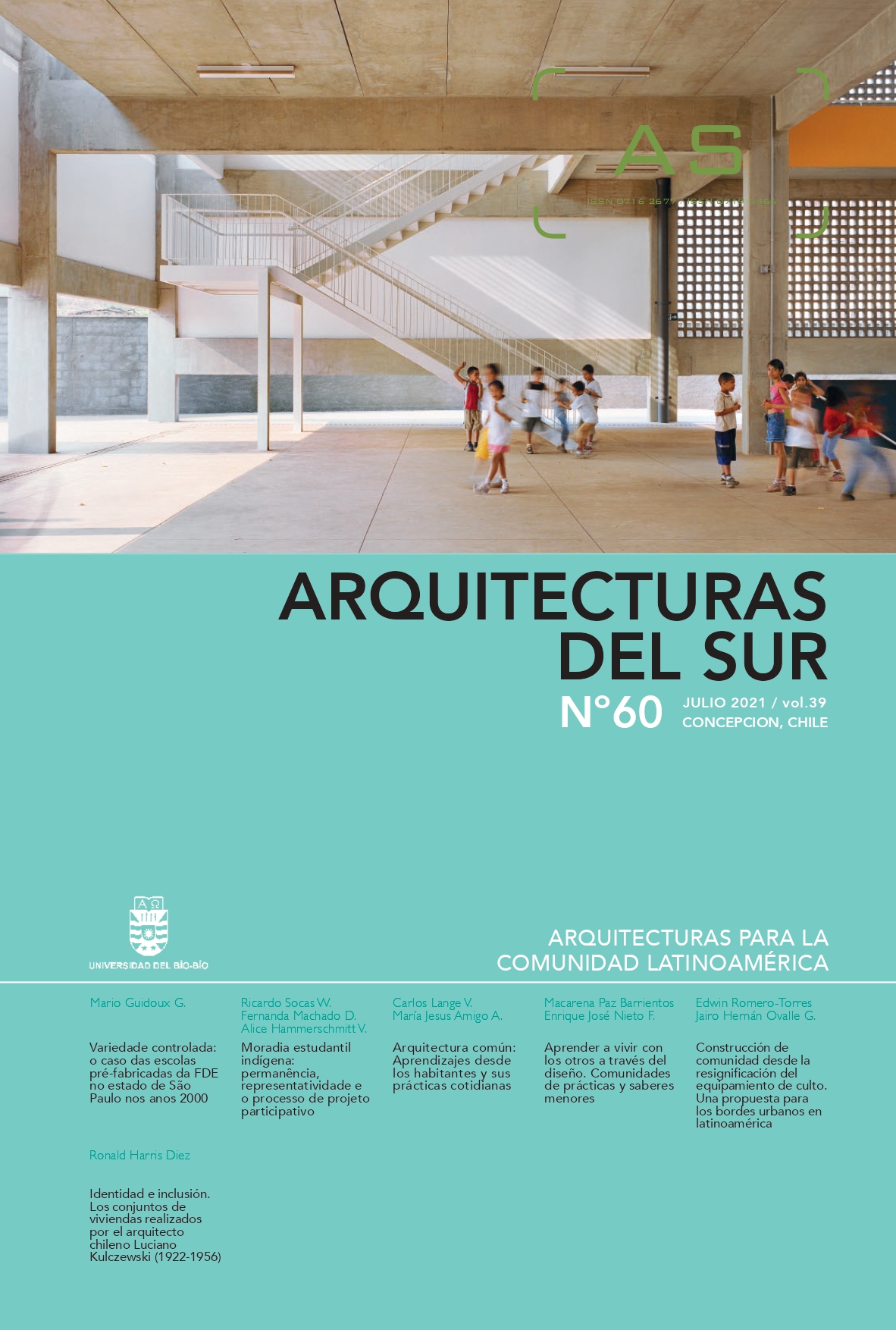Common architecture: learning from the inhabitants and their everyday practices
DOI:
https://doi.org/10.22320/07196466.2021.39.060.03Keywords:
Architecture, Community, Agreements, Urban Improvement, Urban InterventionsAbstract
Over the last decade it has been possible to see growing ties between several architectural groups and urban communities located mainly in territories marked by decay, informality, and inequality. This process has generated a progressive recognition of the value that the daily practices of inhabitants and their communities have in the production of new ways of living, which poses new challenges for the development of the area. Starting from a description and analysis of a neighborhood improvement experience, self-managed by the inhabitants, this article addresses this challenge by proposing the formation of a common architecture, understood as a process of production of spatiality, supported by communalization dynamics that are open to new learnings that incorporate the everyday knowledge of the inhabitants and their communities.
Downloads
References
BOANO, C. Y ASTOLFO, G. (2015). Un nuevo uso de la arquitectura: El potencial político del uso común de Agamben. ARQ (Santiago), (91), 14-25. DOI: https://dx.doi.org/10.4067/S0717-69962015000300003
CHATEAU, F., SCHMITT, C., RASSE, A. Y MARTÍNEZ, P. (2020). Consideraciones para programar la regeneración de condominios sociales en altura. Estudio comparado de tres casos en Chile. Revista INVI, 35(100), 143-173. DOI: https://dx.doi.org/10.4067/S0718-83582020000300143
DE CERTEAU, M. (2000). La Invención de lo cotidiano. Artes de Hacer. México: Ed. Universidad Iberoamericana.
ELORZA, A. L. Y MATTIOLI, D. (2020). Disputas territoriales y resignificación colectiva del hábitat. Notas en torno a la producción de lo común desde el caso de Parque Esperanza, Córdoba, Argentina. Arquitecturas del Sur, 38(58), 62 - 79. DOI: https://doi.org/10.22320/07196466.2020.38.058.04
GIGLIA, A. (2012). El habitar y la cultura: Perspectivas teóricas y de investigación. Barcelona: Anthropos.
JIRÓN, P., LANGE, C. Y GONZÁLEZ, C. (2020). Cachureando por Santiago. Reconociendo la inteligencia urbana situada. Revista 180, (46), 106-117. DOI: https://dx.doi.org/10.32995/rev180.num-46.(2020).art-775
LANGE, C. (2018). Herramientas colaborativas para la producción de conocimiento sobre hábitat residencial. Revista INVI, 33(93), 53-69.
LANGE, C. Y AMIGO, M. J. (2020). Manifiesto para una arquitectura de los espacios comunes en Santiago de Chile. En Colección Investigaciones. IdPA_06 (pp. 123-137). Sevilla: Universidad de Sevilla.
LAVAL, C. Y DARDOT, P. (2014). Común. Ensayo sobre la revolución en el siglo XXI. Barcelona: Gedisa.
LEFEBVRE, H. (1969). El derecho a la ciudad. Barcelona: Península.
LETELIER, F., MICHELETTI, S. Y VANHULST, J. (2016). Prácticas instituyentes en el espacio vecinal: el barrio como un común. Polis (Santiago), 15(45), 105-119. DOI: https://dx.doi.org/10.4067/S0718-65682016000300006
MAGRINI, C. Y CANCINO, M. (2017). Participar. El archipiélago del activismo cívico. En VVAA., Diálogos impostergables (pp.115-132). Santiago de Chile: Metales pesados.
MANZI, M. G. (2020). La ciudad de Santiago resignificada como corporeidad comunicacional temporal en tiempos de estallido social. Arquitecturas del Sur, 38(57), 162-181. DOI: https://doi.org/10.22320/07196466.2020.38.057.09
MÁRQUEZ, F. (2020). Por una antropología de los escombros. El estallido social el Plaza Dignidad, Santiago de Chile. Revista 180, 45, 1-13. DOI: http://dx.doi.org/10.32995/rev180.Num–45.(2020).art–717
MINISTERIO DE VIVIENDA Y URBANISMO [MINVU] (2014). Vivienda social en copropiedad. Catastro nacional de condominios sociales. Santiago: Ministerio de Vivienda y Urbanismo.
OSTROM, E. (2011). El gobierno de los bienes comunes. La evolución de las instituciones de acción colectiva. México: Fondo de Cultura Económica.
PELIOWSKI, A. (2017). Por una historiografía de las colaboraciones: La arquitectura como empresa colectiva. AUS [Arquitectura / Urbanismo / Sustentabilidad], (22), 66-71. DOI:10.4206/aus.2017.n22-11
RUIZ HURTADO, V. M. (2020). Sociabilidad, manifestaciones culturales y conflicto. Bitácora Urbano Territorial, 31(1), 125-137. DOI: https://doi.org/10.15446/bitacora.v31n1.86807
Stoner, J. (2012). Toward a minor architecture. Cambridge: The MIT Press.
TAN, P. (2015). Arquitectura tras la crisis: Un viaje por las prácticas de comunalización contemporáneas. ARQ (Santiago), (91), 114-121. DOI: https://dx.doi.org/10.4067/S0717-69962015000300018
TAPIA BARRÍA, V. (2018). 592. Geografías de la contención: el rol de las políticas de escala barrial en el Chile neoliberal. Scripta Nova. Revista Electrónica de Geografía y Ciencias Sociales, 22. DOI: https://doi.org/10.1344/sn2018.22.20272
URRUTIA, J., COEFFÉ, B., VILLALÓN, T., GONZÁLEZ, J. Y OBLINOVIC, V. (2019). Lo común y lo corriente. En Monroy, P. y Coeffe, B. (Eds.). XXI Bienal de Arquitectura y Urbanismo de Chile 2019: 1. Lo común y lo corriente (pp. 12-17). Santiago de Chile: Fundación Espacio y Desarrollo.
Downloads
Published
How to Cite
Issue
Section
License
Copyright (c) 2021 Carlos Lange-Valdés, María Jesus Amigo-Ahumada

This work is licensed under a Creative Commons Attribution-ShareAlike 4.0 International License.
The content of the articles published in each issue of Arquitecturas del Sur is the sole responsibility of the authors and does not necessarily represent the opinion of University of the Bío-Bío.
The authors will maintain their copyright; however, they will guarantee the journal the right to first publication and dissemination of their work. The publication of the article in Arquitecturas del Sur will be subject to the Creative Commons International license (CC BY-SA) that allows others to adapt: remix, transform and build on the material for any purpose, even commercially; share: copy and redistribute the material in any medium or format, as long as the authorship and first publication in this journal are acknowledged by citing them correctly, and their new contributions are under a license with the same terms.














 Programa de Información Científica/Concurso Fondos de Publicación de Revistas Científicas 2018/ Proyecto Mejoramiento de Visibilidad de Revistas UBB (Código:FP180007)
Programa de Información Científica/Concurso Fondos de Publicación de Revistas Científicas 2018/ Proyecto Mejoramiento de Visibilidad de Revistas UBB (Código:FP180007) 
